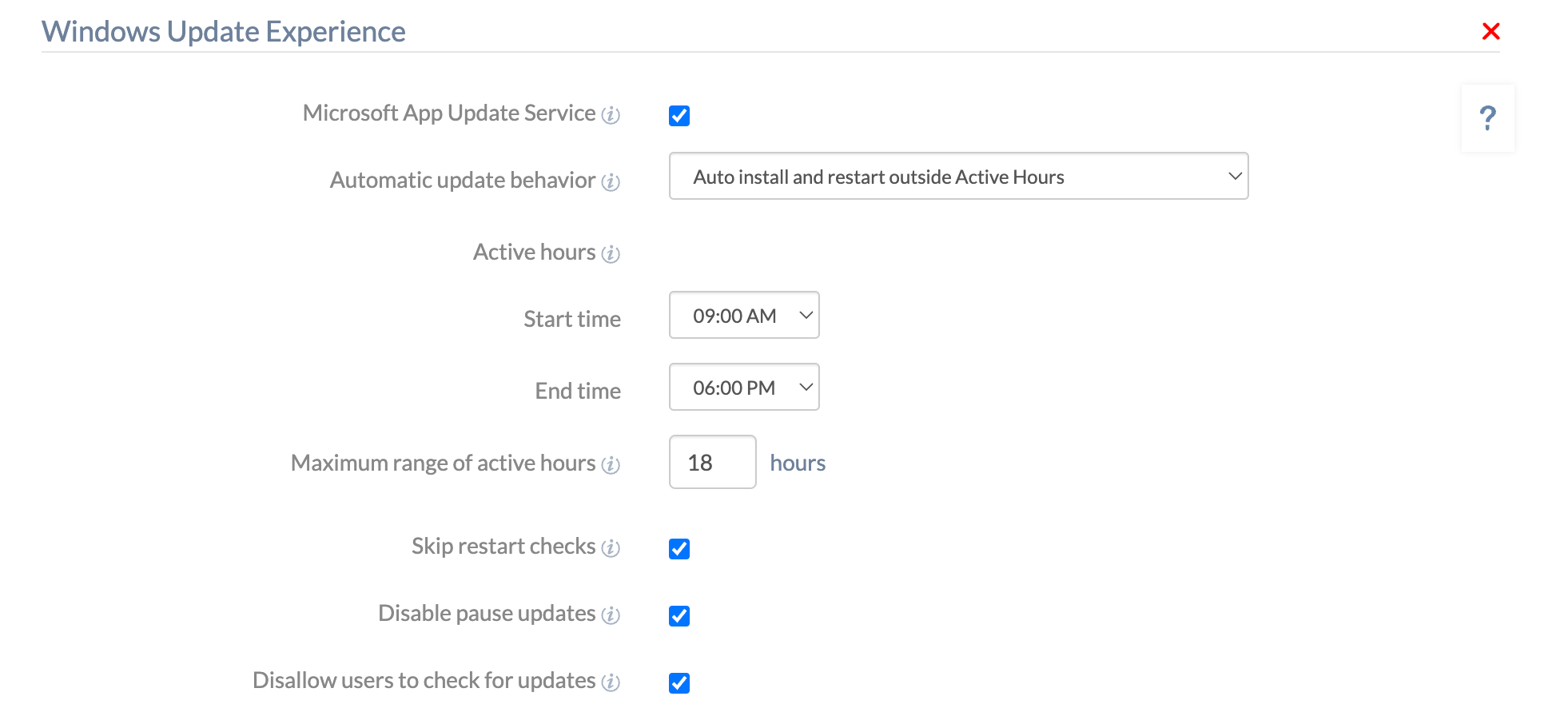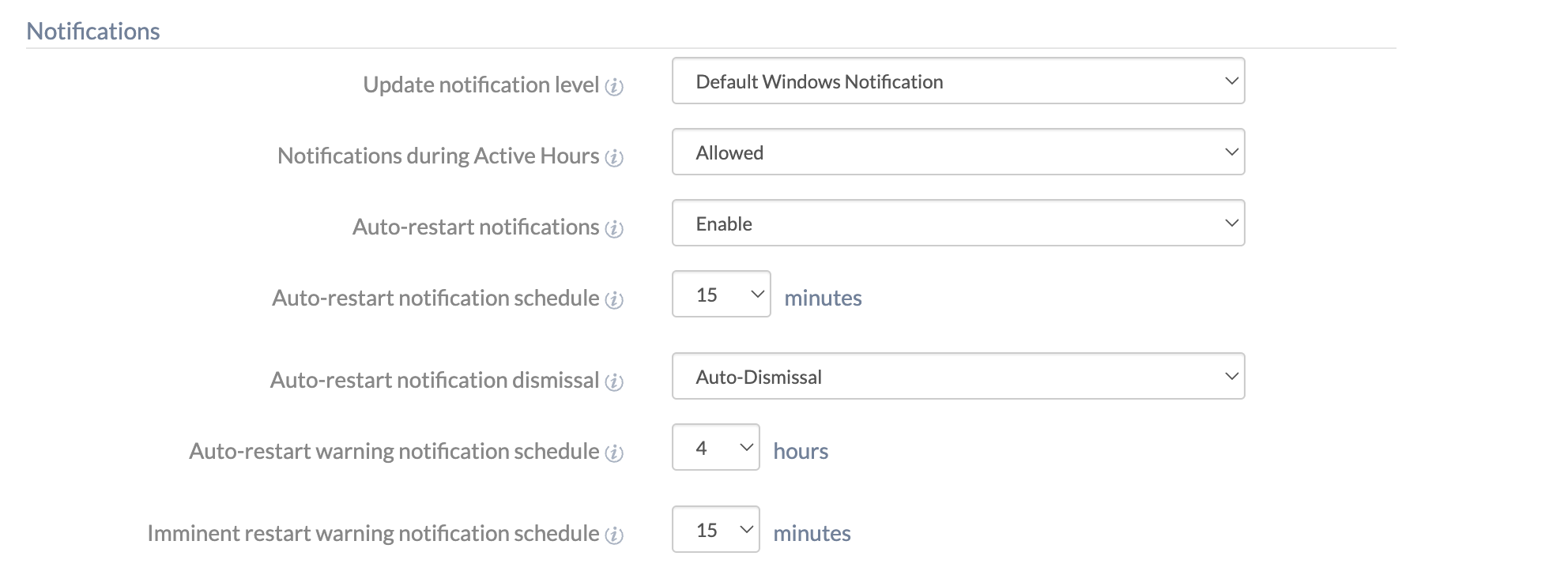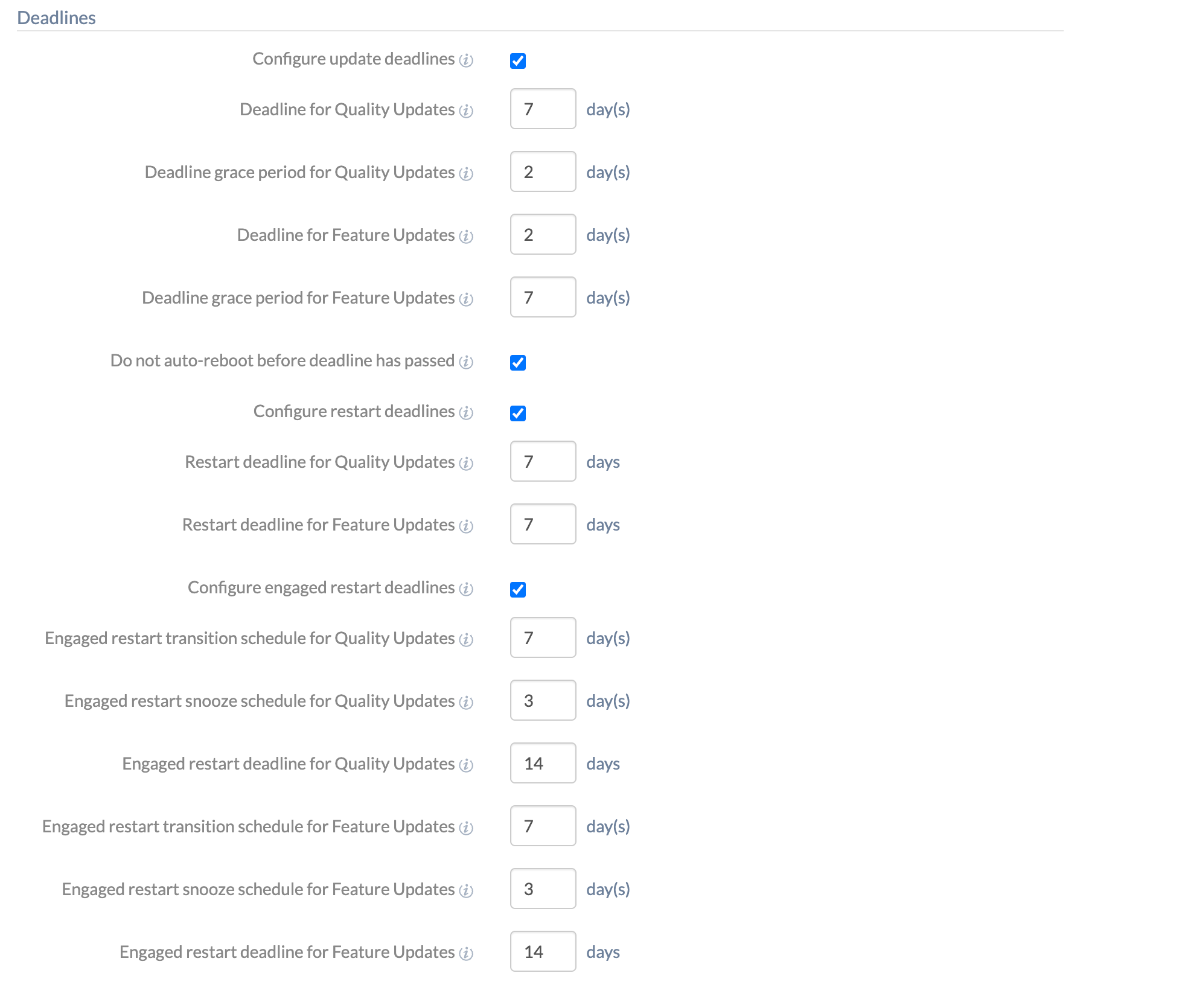Category filter
Configure Windows Update end-user experience with Hexnode UEM
The Patches and Updates feature allows administrators to define Windows Update policies that dictate how and when updates are installed on Windows devices. These policies include settings for update installation, reboot behavior, and deferral options. Also, configuring Windows update user experience is an essential aspect of managing Windows Updates within an organization.
The Windows Update Experience policy helps manage when the device restarts for updates, configuring when an update can be downloaded and installed, setting deadlines for update installations and restarts, and managing how a user can interact with the update process and device restarts. It also lets the administrators configure user notifications regarding pending updates. Notifications can inform users about the availability of updates, impending restarts, etc. This help doc will guide you through the process of configuring Windows Update user experience in your organizational environment.
How to manage Windows update user experience?
The following steps will guide you on how to configure Windows Update user experience settings from Hexnode UEM.
- Log in to your Hexnode UEM portal. Navigate to the Policies tab. Click on New Policy to create a new one. Enter the Policy Name and Description in the provided fields.
(or)
Click on any policy to edit an existing one. - Navigate to Windows. Select Windows Update Experience under Patches & Updates.
- Click on Configure.
Windows Update Experience
Configure Windows update user experience for the Windows devices in your organization using the following options.

Microsoft App Update Service
Check this option to accept updates for other Microsoft products from Microsoft Update Services. Once configured and deployed, unchecking this option or not configuring the option will not revert the configuration on the device.
Automatic update behavior
Configure how the automatic update is initiated and when the device should restart to install the updates.
| Settings | Description |
|---|---|
| Notify users to download and install updates | Notify users when there are updates ready for download, so they can download updates manually. |
| Auto install updates and notify users to restart if required | The “Automatic Maintenance” feature of Windows operating system helps with various routine maintenance tasks for the system to function well. It includes software updates, security scanning, system diagnostics, software maintenance, etc. Automatic Maintenance takes place when the device is not on a metered network, no user is logged in and not running on battery power.
If Automatic Maintenance cannot install an update for two days, then Windows Updates will install the updates automatically. If the installation requires a restart, notify the user to schedule a time for the device to restart after the active hours. Active hours is the period when the update installations and reboots are not scheduled. It can be configured in the fields Start time and End time. Active hours represent the time when a user is logged in and the device is in use. Maximum range of active hours specifies the maximum number of hours (from the Start time) that can be set as Active hours. For example, if the Start time and End time of the active hours are set to be 8:00 AM and 5:00 PM, respectively, and the Maximum range of active hours is set to be 8 hours, then the End time of the Active hours is restricted to 4:00 PM , which is 8 hours from the Start time. |
| Auto install and restart outside Active Hours (Default) | If Automatic Maintenance cannot install an update for two days, then Windows Updates will install the updates automatically outside of the specified active hours. Active hours can be configured by setting up a Start time and an End time. Active hours represent the time when the device is in an active session, where a user is logged in and the device is in use. Maximum range of active hours specifies the maximum number of hours (from the Start time) that can be set as Active hours. If the Active hours exceed the maximum range, then the configured End time for the Active hours is restricted according to the range specified by the Maximum range of active hours. |
| Auto install and restart at specified time | Mention a specific day and time for the automatic installation of the update. The restart of the device takes place after a 15-minute countdown from the time of installation. Users can interrupt this countdown to delay the restart of the device during their active session.
Specify at least a week among the four weeks in a month corresponding to Schedule frequency. The range of days that fall under the selected week is as follows:
Configure Scheduled Install Day and Scheduled Install Time in combination with Schedule frequency to specify a particular point of time for the automatic installation of the update. |
| Disable user control, auto install and restart at a specified time | Mention a specific day and time for the automatic installation of the update. If Automatic Maintenance cannot install an update for two days, then Windows Updates will install the updates right after the download. If the update installation requires a restart, the restart takes place when the device is not in use. The user control over the restart of the device after the 15-minute countdown is disabled.
Specify at least a week among the four weeks in a month corresponding to Schedule frequency. The range of days that fall under the selected week is as follows:
The time for the installation of the update can be configured by the options Schedule frequency, Scheduled Install Day and Scheduled Install Time. For example, if the update has to take place at 8:00 PM every second Tuesday of a month. Then the Schedule frequency can be set to Second week of every month, Scheduled Install Day to Tuesday, and Scheduled Install Time to 8:00 PM. |
| Turn off automatic updates | Turn off automatic update behavior for Windows software updates. |
Skip restart checks
Enabling this option skips restart checks. It limits updates to download and install (outside of Active hours). Updates will be downloaded and installed, even if there is a user logged in or the device is running on battery power, provided there is more than 70 percent battery capacity. Windows will wake the device from sleep 1 hour after the End time configured in Active hours, with a 60-minute random delay. The device will initiate a reboot to install the updates immediately after the download. For four hours, the device will keep trying every hour if there are any more pending updates that need to be downloaded.
- More than 70% – allowed to start downloading and installing updates.
- More than 40% – allowed to restart the device.
- More than 20% – allowed to continue the downloading and installing of the remaining pending updates.
Disable pause updates
Checking this option will deny users access to the “Pause updates” feature on the Windows device.
Disallow users to check for updates
Check this option to deny users from scanning for new software updates on Windows devices.
Notifications
Here, you can set up the Windows update user experience for how or when the notifications related to the updates are shown to the user. Configure Windows Update notification preferences such as:
- Filtering what type of notifications are to be shown.
- Deciding whether to allow notifications during active hours.
- Choosing when an auto-restart notification is to be scheduled.
- Managing user interaction on notifications using the following settings.
Update notification level
Configure what type of Windows Update notifications are shown to the users.
| Settings | Description |
|---|---|
| Default Windows Notifications | Select this option to set the Windows Update notifications to its default preferences. Selecting this option will allow all types of Windows Update notifications such as critical security updates, Quality Updates, Feature Updates and restart warning notifications. |
| Turn off all notifications, excluding restart warnings | Turn off all Windows Update notifications such as critical security updates, Quality Updates, and Feature Updates, except for the restart warning notifications. |
| Turn off all notifications, including restart warnings | Turn off all Windows Update notifications such as critical security updates, Quality Updates, and Feature Updates, including restart warning notifications. |
Notifications during Active Hours
Specify whether to allow or disable Windows Update notifications during the Active hours on the Windows devices. If not configured, the Windows default notification settings will be applied.
Auto-restart notifications
Specify whether to disable auto-restart notifications for Windows Update installations. This option is set to Enabled by default. If you choose to enable this option, the following configurations can be applied:
Auto-restart notification schedule
Mention the time to notify the user before the scheduled restart initiates. An option from 15 minutes, 30 minutes, 60 minutes, 120 minutes, and 240 minutes can be chosen. If not configured, the default value of 15 minutes is applied for this option.
Auto-restart notification dismissal
Select a method of dismissal for the auto-restart required notification (to install Windows Updates) on the Windows devices. If not configured, the option is set to Auto Dismissal by default.
| Auto-dismissal | By default, the Windows system dismisses auto-restart required notification (before installing Windows Updates) in 25 seconds. |
| User-dismissal | Select this option to let the user dismiss the auto-restart required notification (before installing Windows Updates) manually, from the device end whenever required. |
Auto-restart warning notification schedule
Specify when to send warning notifications to users about a scheduled restart deadline (for the update installation). An option from 2 hours, 4 hours, 8 hours, 12 hours, and 24 hours can be chosen. Users will not be able to postpone the scheduled restart once the deadline has been reached and the restart is executed automatically. If not configured, the default value of 4 hours will be selected for this option.
Imminent restart warning notification schedule
Mention the time in minutes to display the warning reminder to the users before an imminent restart. An option between 15 minutes, 30 minutes, and 60 minutes can be chosen. If not configured the default value of 15 minutes is applied for this option.
Deadlines
In this section, you can configure the Windows update user experience by setting up deadlines for updates including:
- Update installation
- Restarts
- Engaged restarts for Feature/Quality Updates
- Set grace periods for updates
Configure deadlines for update installation, restarts, engaged restarts for Feature/Quality Updates, or set grace periods for updates on Windows devices using the following settings.
Configure update deadlines
Enable the option to configure the deadlines for Quality Updates and Feature Updates. After the deadline passes, restarts to install updates will take place regardless of active hours and users won’t be able to reschedule.
Deadline for Quality Updates
Mention the number of days between 0 to 30 before Quality Updates are installed on a device automatically regardless of active hours. The value is set to 7 days by default. Before the deadline passes, users can schedule restarts, and automatic restarts can take place outside active hours.
Deadline grace period for Quality Updates
Specify the minimum number of days between 0 and 7 that the system must wait until a restart takes place automatically to install Quality Updates on the Windows devices. This value is set to 2 days by default. If the value is set to 0, the updates will be downloaded and installed immediately once they become available.
Deadline for Feature Updates
Mention the number of days between 0 to 30 before Feature Updates are installed on a device automatically regardless of active hours. The value is set to 2 days by default. If the value is set to 0, the updates will be downloaded and installed immediately once they become available. Before the deadline passes, users can schedule restarts, and automatic restarts can take place outside active hours.
Deadline grace period for Feature Updates
Specify the minimum number of days between 0 and 7 that the system must wait until a restart takes place automatically to install Feature Updates on the Windows devices. This value is set to 7 days by default. If the value is set to 0, the updates will be downloaded and installed immediately once they become available.
Do not auto-reboot before deadline has passed
Checking this option will delay automatically restarting until both the deadline and grace period have expired, even if applicable updates are already installed and pending a restart. Once both deadline and grace period are expired the restart takes place regardless of active hours.
Configure restart deadlines
Enable the option to configure the deadline in days before automatically executing a scheduled restart to install Quality Updates or Feature Updates.
Restart deadline for Quality Updates
Mention the number of days between 2 to 30 before automatically restarting to install Quality Updates. This value is set to 7 days as a default.
Restart deadline for Feature Updates
Mention the number of days between 2 to 30 before automatically restarting install Feature Updates. This value is set to 7 as a default.
Configure engaged restart deadlines
An engaged restart is a user-scheduled restart.
Enable this option to configure the transition period for the auto restart to change to engaged restart, the number of days a user can snooze an engaged restart and a deadline for the engaged restart to install Quality Updates and Feature Updates.
Engaged restart transition schedule for Quality Updates
Specify a period between 0 to 30 days to delay the transition of auto restart to engaged restart for the installation of Quality Updates. If the setting is not configured or set to 0 the device will be restarted according to the default auto-restart schedule.
Engaged restart snooze schedule for Quality Updates
Specify the number of days between 1 to 3 which a user can snooze an Engaged restart reminder notifications for Quality Updates. This option is set to 3 days as default.
Engaged restart deadline for Quality Updates
Specify the number of days between 2 and 30 as the deadline for the system to wait. From the time Quality Updates are pending restart, if the user did not schedule an engaged restart until the specified deadline has been reached, the restart will be automatically scheduled and executed regardless of active hours.
Engaged restart transition schedule for Feature Updates
Specify a period between 0 to 30 days to delay the transition of auto restart to engaged restart for the installation of Feature Updates. If the setting is not configured or set to 0 the device will be restarted according to the default auto-restart schedule.
Engaged restart snooze schedule for Feature Updates
Specify the number of days between 1 to 3 which a user can snooze an Engaged restart reminder notifications for Feature Updates. This option is set to 3 days as default.
Engaged restart deadline for Feature Updates
Specify the number of days between 2 and 30 as the deadline for the system to wait. From the time Feature Updates are pending restart, if the user did not schedule an engaged restart until the specified deadline has been reached, the restart will be automatically scheduled and executed regardless of active hours.
Apply the Windows Update Experience settings to target entities using Hexnode UEM
There are two ways by which you can associate the policy to configure Windows update user experience with devices.
If you haven’t saved the policy yet,
- Navigate to Policy Targets.
- Click on + Add Devices.
- Search, and select the devices to which you need to apply the policy. Click OK.
- Click on Save to apply the policies to the devices.
If you’ve already saved the policy and taken to the page which displays the policy list,
- Select the required policy.
- Click on Manage and select Associate Targets.
- Search and select the Devices/ Users/ Device Groups/ User Groups/ Domains to which you need to apply the policy. Click Associate.




